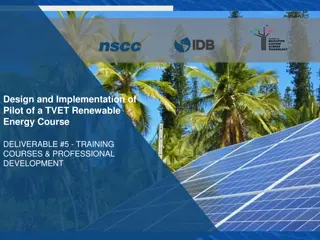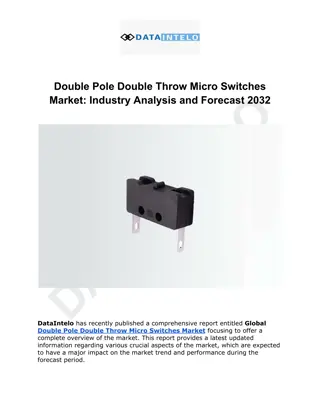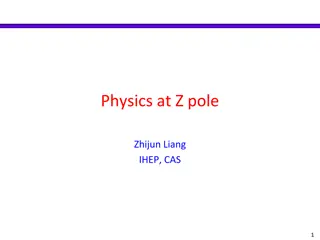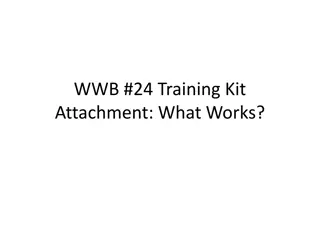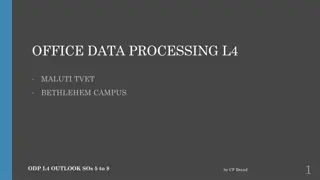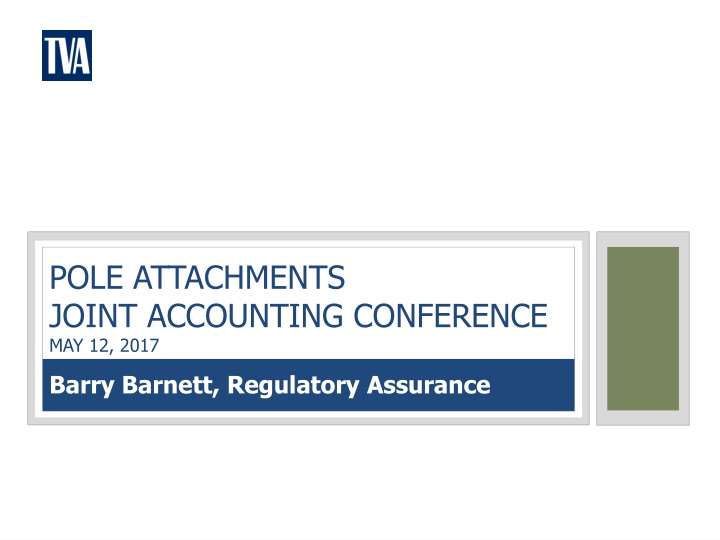
Pole Attachment Update and Outliers Analysis
"Explore the latest developments in pole attachment rates and outliers in this comprehensive analysis. Learn about the new rate implementation, rationale behind establishing the maximum rate, and how it affects pole attachment operations. Stay informed on the regulatory changes shaping the industry."
Download Presentation

Please find below an Image/Link to download the presentation.
The content on the website is provided AS IS for your information and personal use only. It may not be sold, licensed, or shared on other websites without obtaining consent from the author. If you encounter any issues during the download, it is possible that the publisher has removed the file from their server.
You are allowed to download the files provided on this website for personal or commercial use, subject to the condition that they are used lawfully. All files are the property of their respective owners.
The content on the website is provided AS IS for your information and personal use only. It may not be sold, licensed, or shared on other websites without obtaining consent from the author.
E N D
Presentation Transcript
POLE ATTACHMENTS JOINT ACCOUNTING CONFERENCE MAY 12, 2017 Barry Barnett, Regulatory Assurance
Outline Pole Attachment Update Outliers Contract Amendment Highlights o Status o Rate Approval Process o Guideline Adjustment Scale o Escalation Options Approval Process Guideline Adjustment Scale DARS Page 36 Resources Q&A 2 TVA Restricted Information - Deliberative and Pre-Decisional Privileged
Pole Attachment Update Pole Attachment Rate Regulation 14 LPCs have executed a contract amendment to implement their new pole attachment rate; remaining LPCs will implement no later than January 2018 131 LPCs submitted their 2016 pole attachment templates 4 TVA Restricted Information - Deliberative and Pre-Decisional Privileged
Outliers Maximum Valley Pole Attachment Rate $36 (1-Foot) and $39 (2-Foot) Outlier Approach Analysis of all 154 LPCs pole rates using standard 50% depreciation rate One standard deviation above the mean from this data set 50% depreciation represents the expected depreciation rate for a large set of data over a long period of time LPCs will continue to utilize actual data, including actual depreciation, to calculate their date; however, the LPC calculated rate will be subject to the established maximum rate 6 TVA Restricted Information - Deliberative and Pre-Decisional Privileged
Outliers Rationale for establishment and implementation of the maximum rate includes: Depreciation rates Applying the 50% depreciation to the full cost recovery formula results in neither the under nor over-collection of revenue. Attaching parties will not be burdened with the cost of new plant, and LPCs with low depreciation rates are enabled to collect needed revenue for plant replacement. Limited historical reviews - TVA has not historically conducted detailed reviews of some key elements of the pole attachment rate calculation such as pole counts, pole costs, and numbers of attaching parties. The approach helps mitigate potentially less efficient LPC operations. Rate variability Significant variations in pole attachment rates among neighboring LPCs can be mitigated by applying this approach. 7 TVA Restricted Information - Deliberative and Pre-Decisional Privileged
Outliers TVPPA s Regulatory Advisory Group and Board had opportunity to review the outlier approach and provide feedback TVA may modify this approach and/or take other reasonable measures to ensure the approach is accurate and effectively accounting for LPC rates outside certain statistical parameters Impacted LPCs Rate outlier approach was shared with LPCs Customer Delivery discussed, in detail, with the 41 impacted LPCs 8 TVA Restricted Information - Deliberative and Pre-Decisional Privileged
Contract Amendment Highlights Contract Amendment Status TVPPA is working to provide TVA with additional input on the proposed contract amendment (expected in early June) Once that input is received, TVA will need time to review the amendment with Rates and Contracts, and then finalize (expected in July) Rate Approval The contract envisions LPC submitting its Pole Attachment Template to TVA within 15 days of submitting its annual report Following both the execution of the contract amendment and LPC s submittal of its pole attachment template, TVA will provide LPC with a letter documenting its TVA-approved pole attachment rate. Beginning in 2018, between January 1 and March 31 of each year, TVA will provide LPC with its most updated TVA-approved pole attachment rate That rate will be used by LPC in contracts with all new and renewing parties 10 TVA Restricted Information - Deliberative and Pre-Decisional Privileged
Contract Amendment Highlights Guideline Adjustment Scale In instances where there is a variance between the current pole attachment rate and the TVA-approved pole attachment rate, then LPC must use the Guideline Adjustment Scale to transition to the TVA approved rate Guideline Adjustment Scale: Monthly - Adjustment (+/-) Low Dollar Variance $0 - $5 $6 - $10 $11 - $20 $21 - $30 $31 or greater *Transition period begins upon effective date of new or updated contract with Attaching Party. Transition Period* Immediate action No more than 2 years No more than 3 years No more than 4 years No more than 5 years High $ - $0.21 $0.31 $0.44 $0.52 $0.42 $0.42 $0.56 $0.63 $ >0.52 11 TVA Restricted Information - Deliberative and Pre-Decisional Privileged
Contract Amendment Highlights Escalation Options Once LPC s Current Rate reaches the TVA-approved Pole Attachment Rate, after any necessary application of the Guideline Adjustment Scale, LPC must adjust its Pole Attachment Rate in accordance with either of the options below: 1. Handy-Whitman Index*, on a monthly, semi-monthly, or yearly basis (as determined by agreement between LPC, Attaching Parties, or LPC s electric, broadband, and any other legally-affiliated divisions) Rate escalation may not exceed the maximum rate that may be established by TVA 2. The most recent TVA-approved pole attachment rate. *Note: If adjustment of the pole attachment rate using the Handy-Whiteman Index results in a rate that exceeds the most recent TVA-approved pole attachment rate by 15% or more, then LPC must submit the Escalated Pole Attachment Rate to TVA for a new Pole Attachment Rate. In these cases, LPC will then use the new TVA-approved pole attachment rate in its agreements with those affected attaching parties. 12 TVA Restricted Information - Deliberative and Pre-Decisional Privileged
Rate Approval Process Beginning in Fall 2017: Pole Attachment template is due 15 days after DARS report is completed and submitted to TVA Regulatory Assurance will verify / review template inputs and required documentation Any modifications necessary will be addressed with the LPC to correct, etc. Deep dive by Regulatory Assurance Analyst, if necessary Approved rates will be provided to LPC between January and March 2018 14 TVA Restricted Information - Deliberative and Pre-Decisional Privileged
Rate Approval Process 15 TVA Restricted Information - Deliberative and Pre-Decisional Privileged
DARS Page 36 Best Practices 2017 Annual Report Data Entry for DARS Page 36: DARS Page 36 serves as the document of record for each LPC s pole attachment data Enter a separate record for all attachers (including joint use) Fully complete all fields for each attacher If the LPC does not have a contract with an attacher get one! Once DARS Page 36 has been filled out by the LPC, the information on it will roll forward each year and only require the LPC to update (versus enter it from scratch) 17 TVA Restricted Information - Deliberative and Pre-Decisional Privileged
Data Inputs DARS Page 36 DARS Page 36 requires LPC input for 16 values on page 1 (highlighted cells) Standard Rural/Urban Default 37.5 ft. Can change with proper documentation 18 TVA Restricted Information - Deliberative and Pre-Decisional Privileged
Pole Information Input #1 Number of Poles No of distribution poles in Account 364 DARS Page 36 Input #2 Attaching parties different from standard? Enter N if using the Standard Assumption Enter Y if using Probability Method or Actual System Data Note: If answer is Yes, then LPC must provide documentation Input #3a and Input #3b - Pole Height and Discount Factor different than standard assumption Y/N? Enter N in both fields if using the default pole height/discount factor Enter Y if using actual system data. Note: If LPC is using actual system data for either input, they must use it for both inputs and provide documentation for both numbers to TVA. 19 TVA Restricted Information - Deliberative and Pre-Decisional Privileged
Pole Information (continued) DARS Page 36 Input #4 Customers per mile Enter the LPC s number of customers per mile. Note: The number entered here determines which Standard Assumption option the LPC can use on their pole attachment template (Standard Assumption-Rural or Standard Assumption-Urban) Input #5 Comment General comment field related to pole information 20 TVA Restricted Information - Deliberative and Pre-Decisional Privileged
Attaching Entity Information Input #6 Attaching entity NOTE: Enter ALL contracts with attaching parties (joint use, evergreen, term) Enter the name of each attaching entity in a separate record (for example, A&T, Charter, Comcast, etc.) DARS Page 36 Input #7 Term of contract Enter the term of the contract with the attaching entity and give indication if contract is Evergreen or Joint-Use. Some examples: Automatically renews every year (evergreen) 10 years (joint use) 10 year contract with 1st renewal for 5 years, can be renewed until 2027 (term) 21 TVA Restricted Information - Deliberative and Pre-Decisional Privileged
Attaching Entity Information Input #8 Early termination (Y/N)? Can the contract be terminated early (Y/N)?of each attaching entity in a separate record (for example, A&T, Charter, Comcast, etc.) Note: We expect there will be very few instances where the LPC cannot exit these contracts in certain conditions (such as nonpayment, for cause, etc.). DARS Page 36 Input #9 Details Enter any other details about the contract and the details for early termination, such as: Early termination provisions are for cause and non- renewal, no other types of early out Cause and non-payment Can be terminated on the annual renewal date by either party with 60 days prior notice 6 months notice 22 TVA Restricted Information - Deliberative and Pre-Decisional Privileged
Attaching Entity Info (Continued) Input #10 Beginning date The beginning date of the agreement the LPC has in place with the attaching party DARS Page 36 Input #11 Ending date The ending date of the agreement the LPC has in place with the attaching party 23 TVA Restricted Information - Deliberative and Pre-Decisional Privileged
Attaching Entity Info (Continued) DARS Page 36 Input #12 TVA Approved Date The date TVA approved the LPC s pole attachment rate Input #13 Current Rental Rate The rate the LPC is charging the attacher according to the current agreement in place 24 TVA Restricted Information - Deliberative and Pre-Decisional Privileged
Attaching Entity Info (Continued) Input #14 Calculated Rental Rate - TVA Methodology Enter the calculated pole attachment rate after it is verified by TVA DARS Page 36 Input #15 TVA Approved Rate Enter the TVA approved pole attachment rate Note: This will either be the calculated rate used as Input #14, or the TVA rate cap) Input #16 Rate Escalation Method Enter the method of escalation (Handy Whitman or TVA Pole Attachment Template) and also indicate if LPC is using the Guideline Adjustment Scale to transition rate 25 TVA Restricted Information - Deliberative and Pre-Decisional Privileged
Resources Regulatory Assurance Staff Barry Barnett 865-632-2107; jbbarnett@tva.gov Regulatory Assurance Field Accountants Customer Delivery Staff OnlineConnections Pole Attachment Templates and Instructions Pole Attachment Tool Kit Tips, Guidance, Resources 26 TVA Restricted Information - Deliberative and Pre-Decisional Privileged
Questions? 27 TVA Restricted Information - Deliberative and Pre-Decisional Privileged
Thank you 28 TVA Restricted Information - Deliberative and Pre-Decisional Privileged



